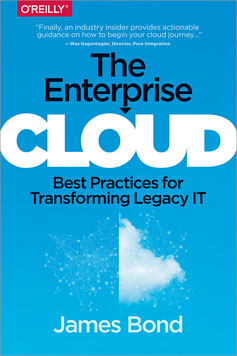"IT Drives Business" entries

The importance of orchestration in transforming legacy IT
How orchestration differs from automation in the enterprise cloud.

Buy The Enterprise Cloud.
The orchestration of workflow processes is an essential part of cloud computing. Without orchestration, many of the benefits and characteristics of cloud computing cannot be achieved at the price point that cloud services should be offered. Failure to automate as many processes as possible results in higher personnel labor costs, slower time to deliver the new service to customers, and ultimately higher cost with less reliability.
What is meant by automation? Automation is technique used in traditional data centers —and critical in a cloud environment — to install software or initiate other activities. Traditional IT administrators use sequential scripts to perform a series of tasks (e.g. software installation or configuration); however, this is now considered an antiquated technique in a modern cloud-based environment. Orchestration differs from automation in that it does not rely entirely on static sequential scripts but rather sophisticated workflows; multiple automated threads; query-based and if/then logic; object-oriented and topology workflows; and even the ability to back-out a series of automated commands if necessary.
Orchestration can best be explained through a typical use case example of a customer placing an order within their cloud service web-portal, and following the steps necessary to bring the service online. The actions below illustrate a very high level scenario where the cloud management software performs the orchestration:

Signals from the 2015 O’Reilly Velocity Conference in Santa Clara
Key insights from DevOps, Web operations, and performance.
People from across the Web operations and performance worlds are coming together this week for the 2015 O’Reilly Velocity Conference in Santa Clara. Below, we’ve assembled notable keynotes, interviews, and insights from the event.
Think like a villain
Laura Bell outlines a three-step approach to securing organizations — by putting yourself in the bad guy’s shoes (without committing actual crime, she stresses):
- Think like a villain and be objective: identify why and how someone would attack your company; what is the core value they’d come to steal?
- Create a safe place to create a little chaos: don’t do it live, but find a safe place without restriction and without fear to break things, to practice creative chaos.
- Play like you’ve never read the the rule book: Not everyone plays by the same rules as you, so to protect yourself and your company, you have to think more like the person willing to break the rules.

Unleash innovation in the enterprise
Winning organizations continually experiment.
I constantly hear how enterprises are poor at innovation, bad at product development and unresponsive to business change. So it begs the question, why do so many organizations get it wrong? And what are the key factors to consider when trying to innovate in large organizations?
Typically the factors constraining innovation are conflicting business goals, competing priorities, localized performance measures and success criteria. While these have traditionally been the tools of management — to control workforce behavior and output — in highly competitive and quickly evolving business environments they also have had the adverse effects of killing creativity, responsiveness and ingenuity.
So what are the components needed to unleash innovation in enterprise?

4 significant ways to improve your ability to innovate
Liberate teams from the annual budget cycle.

The use of the traditional annual fiscal cycle to determine resource allocation encourages a culture that thwarts our ability to experiment and innovate. It perpetuates spending on wasteful activities and ideas that are unlikely to deliver value. How can we get out of the rut that is the annual budget process and encourage experimentation and innovation within our organization?
When it comes to budgets, It is hard to let go of the long-held belief that strong, centralized control provides valuable efficiencies. However well it may have served us in an era of lower complexity and slower technical advances, it now creates barriers that prevent us from adapting quickly to emerging opportunities. In this context, the resources and efforts required to gather information, communicate, and monitor rigid centralized processes outweigh any efficiencies gained. As well, a strongly controlled centralized budget process encourages competitive, rather than collaborative, internal behavior. This is counter-productive to innovation, which requires teamwork and collaboration across the organization.

Business at web speed
A "Coded Business" harnesses feedback loops, optimization, ubiquitous delivery, and other web-centric methods.

Seven years ago, Steve Souders and Jesse Robbins came to the realization that they both worked within “tribes” that, while ostensibly quite different, were talking about many of the same things. Front-end developers and engineers were figuring out how to make web pages faster and more reliable, and web operations folks were making deployments faster and more resilient.
And so goes the tale of how Velocity came to be — a conference that brought those tribes together and openly shared how to make the web faster and stronger. In those seven years, quite a lot has changed, and many ideas, terms, and technologies have come into being — some directly as a result of Velocity, others were already in the works. DevOps, Chef, Puppet, Continuous Delivery, HTTP Archive — these were the earlier forays. Soon to follow were AWS, Application Performance Monitoring (APM) products, many more monitoring tools, many more CDN vendors, WebPageTest, the explosion of the cloud, Chaos Monkey, mobile everything, Vagrant, Docker, and much, much more.
Out of the fire of Velocity came a New Way of doing things forged in a web-centric world. Along the way, something changed fundamentally about not just tech companies, but companies in general. As we looked around more recently, we realized it wasn’t just about the web and fast pages any more. Read more…